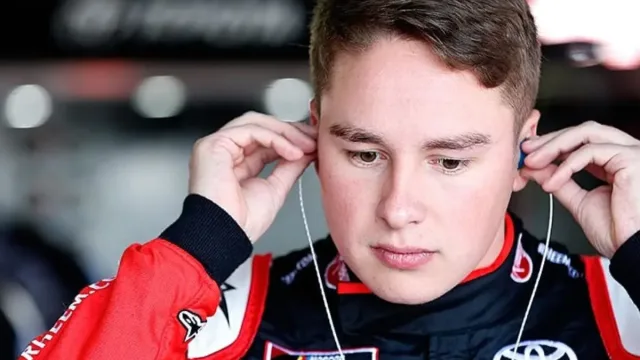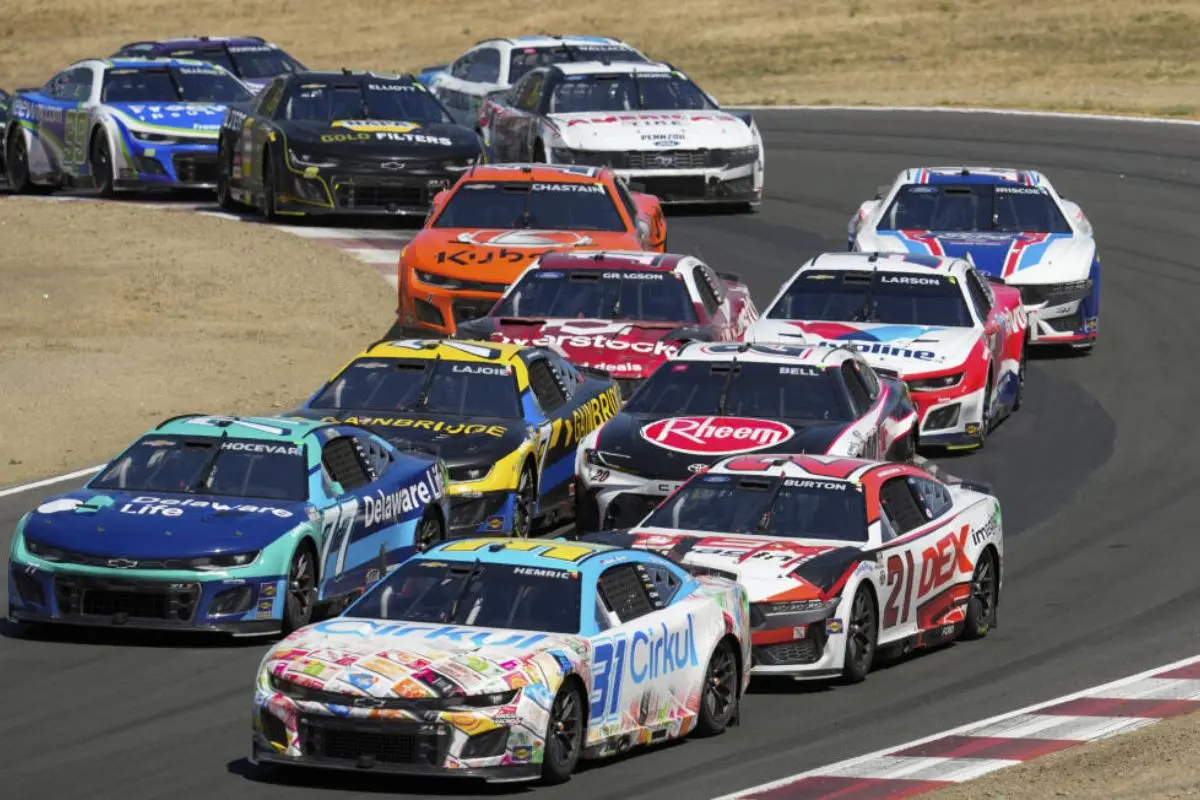Christopher Bell’s Title Dreams Crushed: Christopher Bell‘s championship ambitions were ruined by a considerable penalty imposed by NASCAR during the Xfinity 500, stemming from an aggressive tactic that breached safety regulations. This decision, supported by Kevin Harvick, emphasizes NASCAR’s firm stance on prioritizing safety over competitive strategies. The implications of strict enforcement, particularly around unwritten rules, resonate throughout the racing community, prompting a re-evaluation of strategies for success. Christopher Bell’s misfortunes, compounded by team leadership decisions, highlight the balance between risk and adherence to safety protocols.
Key Highlights
- Christopher Bell faced a penalty at Xfinity 500 for aggressive driving, eliminating him from Championship 4 competition.
- NASCAR’s strict enforcement of safety rules reflects a shift towards prioritizing driver safety over competitive tactics.
- Kevin Harvick emphasizes the importance of adhering to safety protocols in intense racing environments.
- The incident highlights ongoing debates within NASCAR about the balance between thrilling racing and responsible conduct.
- Christopher Bell’s experience shows the need for drivers to adapt to evolving standards and unwritten rules in the sport.
Christopher Bell’s Championship Hopes Dashed
Although Christopher Bell exhibited remarkable skill and tenacity during the final laps of the Xfinity 500 at Martinsville, his championship aspirations were abruptly ruined by NASCAR’s stringent safety regulations. As he drove his No. 20 Joe Gibbs Racing car, his bold attempt to overtake Bubba Wallace by pushing against the outside wall drew immediate scrutiny from NASCAR officials.
This bold move, similar to Ross Chastain’s “Hail Melon” action, ultimately backfired when it was flagged as a safety violation, resulting in a penalty that eliminated Christopher Bell from competition for the Championship 4.
This incident emphasizes the interplay between competitive spirit and regulatory compliance within NASCAR. Christopher Bell’s aggressive driving style highlighted his resolve to secure a place in the title race, yet it also showed the fine line drivers must tread when pushing the limits of their vehicles.
The penalty not only dashed Christopher Bell’s hopes but also sparked vigorous debate within the NASCAR community regarding the enforcement of safety regulations. Critics argue that such penalties may hinder innovation and risk-taking, while supporters maintain that they are crucial for ensuring driver safety.
In the wake of this controversy, veteran driver Kevin Harvick lent his voice to the discussion, affirming the necessity of NASCAR’s safety protocols. His insights reflect a broader recognition that while the thrill of racing often involves intense actions, the sport’s ultimate priority must remain the well-being of its participants.
Kevin Harvick’s Perspective on NASCAR’s Safety Stance Carries Weight
Kevin Harvick lends substantial credibility to discussions surrounding the enforcement of safety regulations, especially in regard to Christopher Bell’s recent penalty.
Kevin Harvick, a veteran driver with a history of going through NASCAR’s rulebook, recognizes the balance between competition and safety—a balance that has become increasingly significant in view of recent incidents on the track.
Kevin Harvick’s perspective is shaped not only by his experiences but also by his understanding of the evolving nature of racing safety. His history includes a suspension for rough driving, highlighting the necessity of strict adherence to NASCAR’s guidelines.
- Safety Priority: NASCAR’s commitment to safety is paramount in the current racing climate.
- Historical Context: Past penalties show a trend towards stricter enforcement of rules.
- Driver Responsibility: Competitors must prioritize their safety and that of others on the track.
- Evolution of Regulations: NASCAR continually updates its safety protocols in response to emerging concerns.
- Understanding Consequences: Drivers must be aware that actions taken in the heat of competition can have considerable repercussions.
The Hail Melon Rule: NASCAR’s Focus on Safety Over Spectacle
NASCAR’s recent implementation of the “Hail Melon Rule” reflects an essential shift in the organization’s commitment to prioritizing safety over spectacle. This decision arises from safety concerns triggered by Ross Chastain‘s bold wall-riding technique during the 2022 season, which, while thrilling, introduced considerable risks.
Ross Chastain’s tactic not only posed dangers to drivers but also raised alarms about loose debris potentially injuring fans. Such actions, though enchanting, set a perilous example that NASCAR sought to settle.
Kevin Harvick highlighted that a meeting convened shortly after Ross Chastain’s move emphasized an unanimous agreement among drivers: the sport needed to reject such reckless stunts.
“There was a meeting with the drivers and NASCAR [after Chastain’s move] … the wall ride was unanimously voted to say, ‘We don’t need that. We can’t do that,’” – (Kevin Harvick)
The consensus was clear; the thrill of the moment could not overshadow the necessity of safety. “We don’t need that,” Kevin Harvick noted, summarizing the sentiment that the integrity and well-being of all participants must take precedence.
The penalty imposed on Christopher Bell serves as a manifestation of NASCAR’s alignment with these safety ideals. By codifying the Hail Melon Rule, NASCAR is not merely enforcing regulations; it is actively fostering an environment where the safety of drivers and fans is most important.
Joe Gibbs Racing’s Disappointment with the Decision
The recent penalty imposed on Christopher Bell has sparked considerable disappointment within Joe Gibbs Racing (JGR). This sentiment was echoed by Joe Gibbs Racing President Dave Alpern, who described the ruling as “a tough one to lose like this.”
The context surrounding the race further amplifies this discontent, as Christopher Bell faced considerable challenges, including a spin after contact with Corey LaJoie and a pit-stop error that cost him a valuable lap.
While Joe Gibbs Racing’s disappointment is noticeable, it is crucial to recognize the broader implications of NASCAR’s decision. Kevin Harvick highlighted that the ruling was straightforward and aligned with the drivers’ collective commitment to avoiding risky actions.
“the easiest call that NASCAR’s gonna make.” – (Kevin Harvick)
This contrast reveals the tension between competitive ambition and safety protocols, a recurring theme in motorsports.
- Impact on Championship Aspirations: The penalty severely reduces Christopher Bell’s chance at a title run.
- Race Strategy Compromised: Errors during the race were compounded by the penalty, affecting overall strategy.
- Team Morale: Disappointment in leadership decisions can ripple through team dynamics.
- Regulatory Clarity: The ambiguous nature of NASCAR’s unwritten rules raises questions about consistency.
- Future Implications: How this decision may influence Joe Gibbs Racing’s approach to similar situations going forward.
NASCAR’s Clear Message: No More Wall-Riding Tactics
In a decisive action that reverberates throughout the racing community, NASCAR has stated its position against wall-riding tactics, a strategy that gained notoriety following Ross Chastain‘s daring “Hail Melon” tactic. This bold execution, celebrated for its boldness, has now drawn a line in the sand.
With Christopher Bell’s Championship 4 aspirations hanging in the balance, NASCAR’s penalty serves as a clear reminder that the sport values control and safety over spectacle.
Kevin Harvick articulated that while Christopher Bell may not have intentionally mimicked Ross Chastain’s wall-riding approach, the choice to ride the wall instead of slowing down speaks volumes about the seriousness of the situation. In intense moments, such decisions carry considerable weight, and NASCAR’s swift action conveys a firm message: wall-riding is unacceptable, regardless of intention.
“He did get loose … but unfortunately for him, there’s a camera inside the car.” – (Kevin Harvick)
This policy shift highlights NASCAR’s commitment to maintaining the integrity of the sport. The “Hail Melon” move may have etched itself into NASCAR history as a thrilling highlight, but its legacy is now one of caution.
The sanctioning body aims to guarantee that drivers prioritize skill and strategy over risk-laden tactics that could threaten not just championships but also the safety of all participants on the track.
News in Brief: Christopher Bell’s Title Dreams Crushed
The recent developments surrounding Christopher Bell’s championship aspirations emphasize the tension between competitive ambition and safety regulations within NASCAR. Kevin Harvick’s insights highlight the league’s commitment to prioritizing driver safety, even at the expense of traditional racing strategies like wall-riding.
The enforcement of the so-called “Hail Melon Rule” sends a clear message regarding the limits of acceptable tactics. As NASCAR handles the balance between spectacle and safety, the implications for driver strategy and championship outcomes will remain a crucial point of discussion.
ALSO READ: Christopher Bell’s Disastrous Attempt Ends Championship Dreams After NASCAR Ruling



